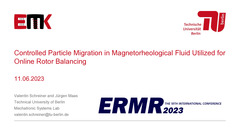Controlled Particle Migration in Magnetorheological Fluid utilized for Online Rotor Balancing
ID:100
Submission ID:108 View Protection:ATTENDEE
Updated Time:2023-05-10 13:38:08 Hits:876
Oral Presentation
Abstract
Rotating machinery is used in a wide range of industrial applications, from power generation and mining to manufacturing and transportation. The performance of these machines is critically dependent on the proper balancing of the rotating components. Unbalanced machines generate excessive vibration and noise, resulting in reduced efficiency and increased maintenance costs.
One promising approach to reduce these disturbing vibrations is a balancing method that utilizes controlled particle migration in magnetorheological fluids (MRF). Migration due to sedimentation is usually undesirable in MRF and a great effort is taken to ensure that the particle concentration is as homogeneous as possible. However, particle migration provides the ability to shift the center of mass of the MRF, and thus of a rotating system and can therefore be used for balancing.
In the associated contribution, the migration process in the MRF and the influencing quantities are first discussed. Special attention is given to a modified fluid with significantly different particle sizes and to the influence of magnetic fields on the stabilization of the MRF.
Based on these investigations, a balancing disk, divided into certain sectors and filled with MRF, is presented, in which a controlled particle migration is utilized for the balancing process. The proposed system is designed for balancing during rotation. Its magnetic circuit consists of a combination of permanent magnets, rotating with the disk, and a stationary electromagnet fixed outside. This configuration allows the generation of a magnetic field that can effectively stabilize the MRF during rotation. The balancing disk is analyzed using multiphysics simulation to gain insight into its behavior under different operating conditions. Finally, experimental tests are performed to further investigate the performance and validate the proposed system for effectively balancing rotating components, reducing vibration and improving overall performance.
Reference:
[1] Schreiner, V.; Hegger, C.; Maas, J.: Automatic active balancing of rotating systems using real-time controlled magnetorheological fluids, Smart Materials and Structures, Vol. 31(10), doi: 10.1088/1361-665X/ac8848, 2022.
[2] Schreiner, V., Maas, J.: Online rotor balancing by weight spheres controlled by magnetorheological fluids. 18th International Conference and Exhibition on New Actuator Systems and Applications, ACTUATOR 2022, Mannheim, Germany, pp. 113-116, 29. - 30. Jun. 2022, ISBN 978-3-8007-5894-4.
Keywords
Particle migration, vibration, online balancing, active balancing
Submission Author
Valentin Schreiner
Technische Universität Berlin
Jürgen Maas
Technical University of Berlin


Comment submit